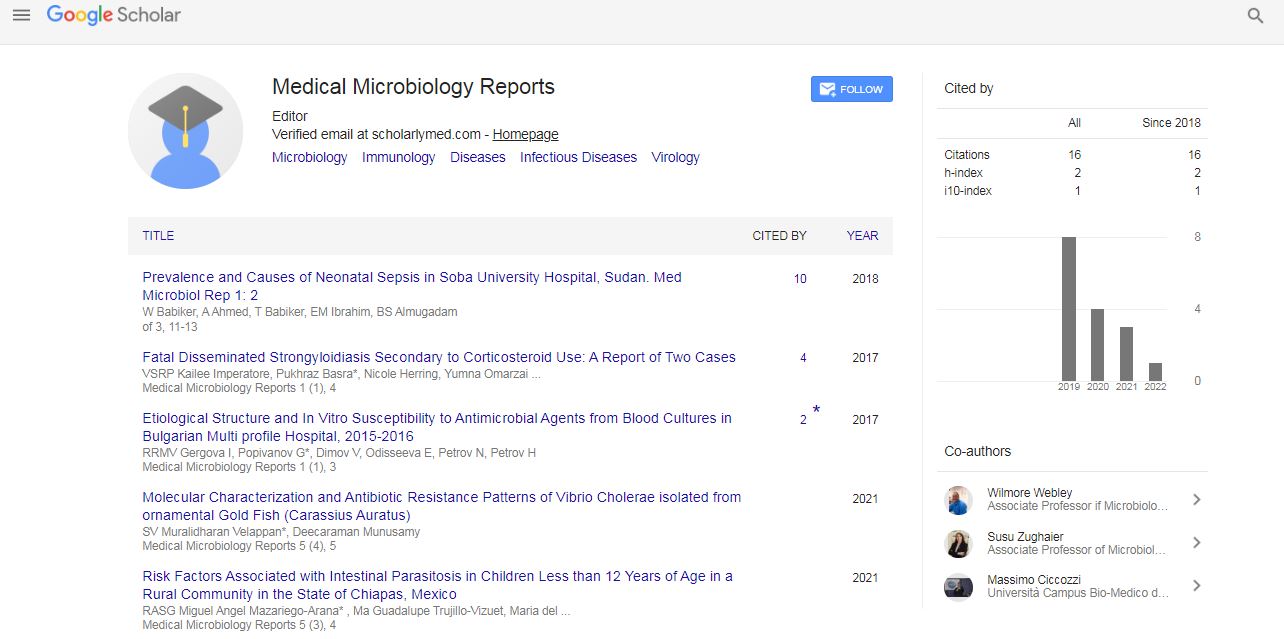Short Communication, Med Microbiol Rep Vol: 7 Issue: 2
Short Note on History and Applications of Bacteriology
Lahcen Braux*
Department of Microbiology, National Polytechnic University, Mexico City, Mexico
*Corresponding Author: Lahcen Braux
Department of Microbiology, National Polytechnic University, Mexico City, Mexico
E-mail: lachebraux@yahoo.com.mx
Received date: 22 May, 2023, Manuscript No. MMR-23-107447;
Editor assigned date: 25 May, 2023, PreQC No. MMR-23-107447 (PQ);
Reviewed date: 08 June, 2023, QC No. MMR-23-107447;
Revised date: 15 June, 2023, Manuscript No. MMR-23-107447 (R);
Published date: 22 June, 2023, DOI: 10.4172/mmr.1000340
Citation: Braux L (2023) Short Note on History and Applications of Bacteriology. Med Microbiol Rep 7:2.
Description
Bacteriology is a field of study that focuses on the identification, classification and understanding of bacteria. These microscopic organisms, despite their small size, play a vital role in shaping the world. From the impact on human health to the contributions in various industries, bacteria have captivated scientists and analysts for centuries.
Bacteria are single-celled microorganisms that belong to the prokaryotic group of organisms. They can be found virtually everywhere, from the depths of the oceans to the highest mountain peaks. With the ability to survive in extreme conditions, bacteria have adapted to thrive in diverse environments, making one of the most successful life forms on Earth [1].
The study of bacteriology dates back to the late 17th century when Antonie van Leeuwenhoek, a Dutch scientist, observed bacteria under a microscope for the first time. His revolutionary discoveries paved the way for further investigations into these minute organisms. However, it was not until the late 19th century that the field of bacteriology began to flourish, largely due to the pioneering work of scientists such as Louis Pasteur and Robert Koch [2].
Louis Pasteur, a French chemist and microbiologist, made significant contributions to the field of bacteriology. His experiments disproved the theory of spontaneous generation and provided evidence for the existence of microorganisms. Pasteur's germ theory of disease revolutionized medicine and led to the development of various vaccines and sterilization techniques, significantly improving public health [3].
Robert Koch, a German physician, is often referred to as the father of modern bacteriology. He established a set of postulates known as Koch's postulates, which served as a framework for identifying the causative agents of infectious diseases. Koch's discoveries, such as the identification of the bacteria responsible for tuberculosis and cholera, laid the foundation for the field of medical bacteriology and the development of effective treatments [4].
At present, bacteriology plays a vital role in several areas. One of the most significant areas of analysis is the study of pathogenic bacteria and infectious diseases. Bacteriologists work to identify and understand the mechanisms by which bacteria cause diseases, allowing for the development of new treatments and preventive measures. Additionally, the analysts even study the emergence and spread of antibiotic resistance, a growing concern in global health [5].
Bacteriology also finds applications in the field of environmental science. Bacteria are involved in various biogeochemical processes, such as nitrogen fixation, decomposition and bioremediation. Understanding the role of bacteria in these processes can help mitigate environmental pollution, improve agricultural practices and promote sustainable development [6].
Bacteriology has made substantial contributions to the field of biotechnology. Bacteria are used in the production of antibiotics, vaccines and various enzymes used in industries such as food and beverage, pharmaceuticals and wastewater treatment. Genetic engineering techniques have allowed analysts to manipulate bacterial genomes, leading to the production of Genetically Modified Organisms (GMOs) with enhanced traits and capabilities [7].
Recent advancements in bacteriology have been driven by technological advancements. The advent of high-throughput Deoxyribonucleic Acid (DNA) sequencing has revolutionized the field, allowing analysts to thoroughly examine the genetic structure of bacteria. Metagenomics, the study of microbial communities without the need for cultivation, has unveiled the vast diversity of bacteria in various environments, leading to the discovery of novel species and potential applications [8,9].
Additionally, the development of advanced imaging techniques, such as electron microscopy and super-resolution microscopy, has enabled analysts to visualize bacteria at the nanoscale level. These techniques provide valuable insights into the structure and behavior of bacteria, facilitating the understanding of the complex biological processes [10].
Conclusion
Bacteriology is a captivating field that has greatly contributed to the understanding of bacteria and the impact on the lives. From diseasecausing pathogens to beneficial microbes, bacteria play diverse roles in various aspects of the world. The analysis on bacteriology continues to evolve with the aid of technological advancements, paving the way for new discoveries and applications.
References
- Rampelotto PH (2013) Extremophiles and extreme environments. Life (Basel) 3:482-485.
- Drews G (2000) The roots of microbiology and the influence of Ferdinand Cohn on microbiology of the 19th century. FEMS Microbiol Rev 24:225-249.
- Tomes N (1990) The private side of public health: Sanitary science, domestic hygiene, and the germ theory, 1870-1900. Bull Hist Med 64:509-539.
- Blevins SM, Bronze MS (2010) Robert Koch and the ‘golden age’of bacteriology. Int J Infect Dis 14:e744-e751.
- Aslam B, Wang W, Arshad MI, Khurshid M, Muzammil S, et al. (2018) Antibiotic resistance: A rundown of a global crisis. Infect Drug Resist 10:1645-1658.
- Saha I, Datta S, Biswas D (2020) Exploring the role of bacterial extracellular polymeric substances for sustainable development in agriculture. Curr Microbiol 77:3224-3239.
- Kuiper HA, Kleter GA, Noteborn HP, Kok EJ (2001) Assessment of the food safety issues related to genetically modified foods. Plant J 27:503-528.
- Losada MP, Arenas M, Galán JC, Bracho MA, Hillung J, et al. (2020) High-Throughput Sequencing (HTS) for the analysis of viral populations. Infect Genet Evol 80:104208.
- Shu WS, Huang LN (2022) Microbial diversity in extreme environments. Nat Rev Microbiol 20:219-235.
- Shrestha HK, Appidi MR, Solis MIV, Wang J, Carper DL, et al. (2021) Metaproteomics reveals insights into microbial structure, interactions, and dynamic regulation in defined communities as they respond to environmental disturbance. BMC microbial 21:308.
 Spanish
Spanish  Chinese
Chinese  Russian
Russian  German
German  French
French  Japanese
Japanese  Portuguese
Portuguese  Hindi
Hindi 
